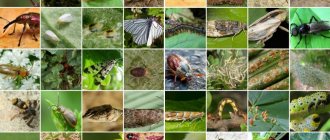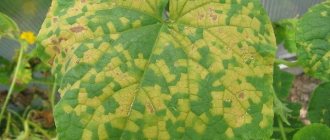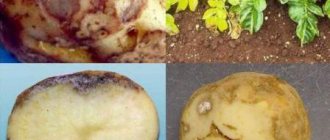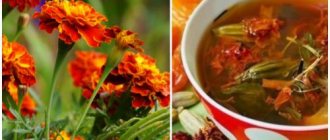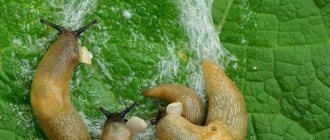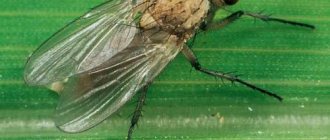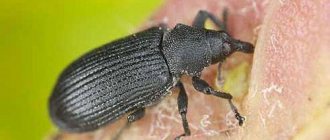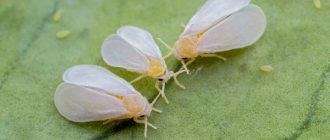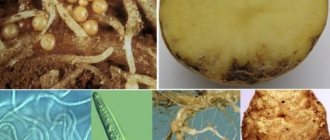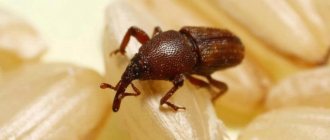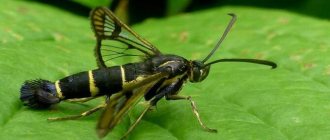Coniferous species are usually not widespread in urban plantings, but they are very widely represented in parks and forests of various natural zones of our country.
In general, the most severely damaged trees by insects are Scots pine, spruce and larch. Fir, Siberian cedar, Weymouth pine, prickly spruce (blue), thuja and juniper suffer much less from insects in parklands.
Foci of mass reproduction of pine-eating pests in parks and forested areas are not often formed, mainly when pests such as pine silkworms, pine cutworms, and pine moths penetrate from neighboring forests.
Sawflies damage pine, spruce and larch mainly in young (up to 20 years old) plantings.
At an older age, coniferous trees, weakened from various reasons, are attacked by bark beetles, longhorn beetles, borers and other stem pests, damage to which often leads to the trees drying out.
General information
Various insects are the main pests of coniferous trees in the garden. There are always a lot of them, and they are so voracious that measures to combat them must be taken immediately. They are rarely limited to one plant and usually attack all similar plants with epidemic speed, which can lead to the death of the plant.
Harm
What conifer pests can do:
- nibble or even completely eat the needles;
- suck the juice out of it, causing it to turn yellow and crumble;
- damage the bark, and then the trunk itself;
- settle in the roots and feed on them.
Almost from the very first days of the invasion, plants lose their attractive appearance. They are crawling with caterpillars, or they are covered with fluff, saliva or cobwebs. Then the needles begin to turn yellow and crumble, and whole pieces of bark fall off. As a result, if no control measures are taken, inevitable death occurs. At the same time, as mentioned above, the epidemic will spread to other similar trees and shrubs.
Classification
The degree of damage and the speed of spread of insects will largely depend on what kind of pests attacked the garden. There are several classifications. For example, one that is based on a biological species:
- weevils;
- goldfish;
- mites, bugs, cocoon moths, root beetles, bark beetles;
- leaf rollers, pine beetles;
- moth;
- moths;
- sawflies, shoots, grasshoppers, moths;
- horntails;
- tars, scoops;
- aphids;
- barbel;
- hermes;
- silkworms;
- Scale insects.
These are the most common families of insects that are the main pests of conifers. However, within them there are also subfamilies, the names of which often indicate the main object of their destruction. For example:
- pine weevil;
- spruce woodcutter;
- spruce and pine bug;
- pine cocoon moth;
- larch leaf roller;
- juniper, spruce, larch moths;
- larch, juniper, spruce, pine sawfly;
- fir and pine moth;
- spruce, juniper, pine, thuja aphids;
- spruce and fir barbel;
- hermes spruce, pine, spruce-fir;
- cedar, pine silkworm;
- juniper and pine scale insects.
But this does not mean at all that if a larch leaf roller attacks the garden, it will only destroy the larch. Yes, first of all it will destroy all the trees of this species, but then it can start attacking others. So the names of the subfamilies are quite arbitrary. The second classification is based on the method of destroying conifers:
- sucking - sucking juices from various parts of a coniferous plant (scale insects, aphids, mites, hermes);
- needle-eaters - eating buds and needles (weevils, sawflies, cutworms, moths);
- cone beetles - damaging cones (pine cone moth, cone moth, pine cone moth);
- trunk beetles - feeding on bark and intra-trunk contents (bark beetles, pine beetles, longhorn beetles, woodcutters);
- root beetles - destroying the roots of coniferous plants (spruce root aphids, root aphids).
As for the classification depending on the orders of insects, these are mainly butterflies and beetles, as well as their larvae and caterpillars.
How to fight
The main control of coniferous pests is carried out using chemical insecticides. They are sold in different forms: as an emulsion concentrate (Prestige KS), water-dispersible granules (Decis Profi), powders (Pinocid), sprays (Magtoxin). When choosing a drug, you should take into account the nature of their effect on pests:
- universal - against several types of insects (for example, Pinotsid protects against hermes, aphids, scale insects, sawflies, leaf rollers);
- acaricides - against ticks (Kleschevit, Nissoran);
- aphicides - against aphids (Biotlin);
- larvicides - destruction of larvae, caterpillars (Iskra, Lepidotsid, ExtraFlor);
- ovicides - getting rid of clutches of insect eggs (Preparation 30 Plus);
- repellents - scarers, used for prevention (Soil, pheromone traps).
Photos of drugs:
It is also useful for gardeners to know that there are natural insecticides. Some plants repel insects with their scent. As a preventive measure, to protect the garden from pest invasion, they can be planted near conifers:
- garden insecticides: garlic, onions, horseradish, cumin, celery, fennel, potatoes, basil, hot peppers, mustard, dill, parsley, tomatoes;
- flowering insecticides: marigolds, calendula, matthiola, nasturtiums, chrysanthemums, petunias, lovage, pelargonium, sage;
- wild insecticidal plants: wormwood, spurge, celandine, elderberry, tansy, tobacco, bird cherry, yarrow, burdock, larkspur.
The first treatment of plants against coniferous pests is carried out in the spring and is preventive in nature. During the summer, it is also recommended not to forget to spray them with insecticides at least once a month. This is a great way to prevent insect infestations, because fighting them is extremely difficult and unpleasant.
Fighting methods
At the first sign of uninvited guests, immediately begin to destroy them. There are 3 “weapons” in the fight against parasites: mechanical cleaning, biological effects, chemicals.
None of these methods will be effective alone. To ensure a guaranteed result, you need to act comprehensively: alternate different techniques.
Mechanical
The first thing to do is to collect pine pests by hand. To do this, be sure to use rubber gloves, glasses, and closed clothing. Anticipating death, the larvae turn on a defense mechanism, releasing allergen substances. After collecting the pests, they are burned.
The pine trunk can be wrapped with a hunting belt. This is a small piece of material smeared with resin, tar or impregnated with insecticide. An insect crawling along the trunk will stick to the trap or die from poison.
Biological
It involves treating foliage with herbal infusions. The most popular recipe is garlic infusion. To obtain it, 250 g of the crushed component is mixed with 1 liter of water. The product is kept for a day, after which it is filtered and diluted with a bucket of water.
Spraying is carried out in dry, windless weather. A positive effect is observed when using tinctures of onions, tomato tops, and tobacco.
For those who are too lazy to tinker with infusions, we can recommend ready-made biological products applied by spraying. Among them are Lepidotsid, Fitoverm. They are safe for humans and the environment and do not accumulate in the soil.
- Gooseberry pests - 110 photos and videos, description, names, treatment, prevention. Features of care and cultivation of gooseberries
- Raspberry chlorosis: description of the disease, treatment methods, disease prevention (145 photos + video)
- Why do gooseberry berries turn white: the reasons for the appearance of a white coating. Diseases and pests of gooseberries (105 photos)
Chemical
With significant damage, you can immediately move on to heavy artillery - chemical insecticides. Moreover, repeated use of one variety causes addiction in the caterpillars. To prevent this from happening, choose 2-3 products.
Let's list how to treat pine against caterpillars in advanced cases:
Inta-Vir is a universal drug suitable for exterminating leaf-eating larvae. Due to its toxicity, it is necessary to work with it strictly according to the instructions, observing safety precautions.
Actellik is an enteric contact reagent active against a wide range of insects. Available in the form of an emulsion, packaged in ampoules and canisters.
Aktara - unlike its analogues, does not have a pronounced pungent odor. Within 30 minutes after application, the larvae stop feeding, and complete death is recorded 24 hours after use.
Weevils
Another name: elephants. Order: beetles (Coleoptera). Kinds:
- large pine;
- small pine (spot tar).
Description:
- a characteristic feature is a highly elongated head, which in botany is called the rostrum;
- body length - from 1 to 30 mm;
- color - yellow, brown, black, perhaps in some species - with spots and a metallic tint.
Signs of infection:
- invasion period - May-June;
- affect the bark and infect the plant with blueweed;
- the main symptom is small wounds on the trunks of young coniferous plants, from which resin begins to actively flow;
- the needles gradually turn red and fall off.
How to fight:
- pollination with barrier action insecticides;
- it is advisable to immediately add a fungicide to the pollination solution to prevent blue staining;
- Once there is information that pests have been spotted in the region, natural insecticidal plants can be used to repel them.
Weevils attack mainly pine, but they also do not disdain spruce and larch. Young plants are primarily at risk. If no control measures are taken, the tree dries out. If it survives, it remains ugly.
Bedbugs
Order: Hemipterans, or arthropodous. Kinds:
- spruce subbark;
- pine root.
Description:
- distinctive feature - odorous glands that secrete an unpleasant odor;
- body length - from 3 to 10 mm;
- color - most often brown, green or red, there may be spots and patterns.
Signs of plant infection:
- sticks to the trunk, breaks the integrity of the bark, sucks out juices;
- the bark begins to peel off in whole pieces;
- under it, spots are found on the trunk - gray-white, brown-red, yellowish;
- the needles turn pale, become thinner, and look painful;
- the top dries out.
How to fight:
- spraying with antiseptics: Lepidocide, Lepidobactocide, Bitoxibacillin;
- spraying with chemical insecticides: Actellik, Confidor;
- treatment of pine with Arborjet, which is injected directly into the trunk;
- spring treatment of conifers with preventive agents: Decis, Karate, Aktara, Enzhio.
Among the folk remedies for controlling such pests, the most effective is treatment with a solution of potassium soap and water, citrus fruit or tobacco infusion. Bed bugs attack mainly pine, but they also do not disdain cedar and larch. Those most at risk are trees with dried out bark, peeling plates, and a green layer of moss on the trunk.
Pests of buds and needles.
Pine moth (lat. Bupalus piniaria).
Damages pine needles, rarely spruce and fir. Young caterpillars eat the tops of the needles, and adults eat the needles completely, leaving only the midribs. Caterpillars feed on old needles during July - September. When damaged again, trees often dry out.
Ways to fight:
- relocation of Formica ant colonies to pest breeding sites;
- spraying with 0.3% chlorophos solution is effective;
- raking litter in the second half of summer into heaps 1.5 m high and 2-3 m in diameter, with pupae overwintering in it, in which the pupae die;
- pollination of trees with calcium arsenic acid or soda fluoride (8-10 kg per 1 ha).
Fir moth (lat. Ectropis crepuscularia).
Harmful to fir. Caterpillars begin to eat needles from the lower tiers of the crown, rising upward. Severely damaged fir trees dry out.
The methods of fighting are the same as against the pine moth.
Pine armyworm (lat. Panolis flammea).
Caterpillars feed on buds, May shoots, young needles, and if there is a shortage of them, they also eat old needles.
The methods of fighting are the same as with the pine moth.
Pine silkworm (lat. Dendrolimus pini).
Early in the spring, overwintered caterpillars climb the trunk and begin to eat old needles. New caterpillars feed on needles in the summer.
Ways to fight:
- laying glue rings 4-5 cm wide and with a glue layer thickness of 3-5 mm, 40-50 kg of glue is consumed per 1 ha;
- pollination with calcium arsenic acid, 8-12 kg are consumed per 1 ha;
- installation of barrier grooves, 35x35 cm in size, around infected areas; the grooves prevent caterpillars from crawling into uninfected areas;
- attracting insectivorous birds.
Siberian cedar silkworm (lat. Dendrolimus sibiricus).
Harms various coniferous species, prefers Siberian cedar and larch. The caterpillars eat the entire needles with the sheath, and also damage young shoots. When the needles are partially eaten, the latter is restored, but the growth of the trees is weakened; with repeated damage, the trees dry out. Caterpillars eat the needles on a tree from top to bottom.
The methods of fighting are the same as with the previous species.
Silkworm nun (lat. Lymantria monacha).
It harms spruce and pine, and also damages larch, cedar, fir, and juniper. Selects mainly middle-aged and mature trees, but is also found on young trees. Caterpillars eat needles from the middle or even at the base, which is why the needles are often chewed through, their remains accumulate in large quantities under the trees. The caterpillars feed mainly on old needles, damaging the tree crown from its lower part, and then climb up. If larches are severely damaged, they lose annual growth and fruit yield.
Ways to fight:
- spraying with Parisian greens in a dosage of 10-15 g with double the amount of quicklime per 10 liters of water;
- pollination with calcium arsenic acid (8-12 kg per 1 ha);
- laying glue rings at a height of 1.3 m from the ground, first smooth the trunk bark, and then spread track glue, 32-40 kg of glue is consumed per 1 hectare;
- crushing caterpillars.
Pine sawfly (lat. Diprion pini).
It is the most harmful of the sawflies, damaging pine trees and most often attacking pine trees at the age of 10-25 years. The larvae stay in groups, eating the needles from the sides and not touching the midrib. Adult pseudocaterpillars eat the entire needles almost to the base. Second generation false caterpillars cause damage in August.
Large larch sawfly and small larch sawfly (lat. Nematus erichsoni).
The most dangerous is the first of these types. Young pseudo-caterpillars eat up the needles, usually leaving the midrib, and adult caterpillars eat all the needles, with the exception of the leaf sheath. When there is massive damage, the false caterpillars damage the bark of thin branches.
Red pine sawfly (lat. Neodiprion sertifer).
The larvae do damage in May - July, eating mainly old needles; during mass reproduction, they also damage young needles and the bark of May shoots, eating out irregular areas and gnawing shoots.
Spruce sawfly (lat. Pristiphora abietina).
False caterpillars eat the needles of shoots of young fir trees 10-20 years old.
Ways to combat sawflies:
- spraying with 0.2-0.3% chlorophos solution is effective;
- raking ground litter with sawfly cocoons into heaps and destroying them;
- autumn loosening of the soil to destroy false caterpillars that have left for the winter;
- pollination with arsenic acid calcium, fluoride and fluoride preparations against false caterpillars at the rate of 8-10 kg per 1 ha.
Spruce bud moth (lat. Gelechia electella L.).
The caterpillars first bore a spiral passage in the bast tissue, and then in the wood of the shoot, and eat away the lateral and then the apical shoots of the spruce. Due to damage to the apical shoot, the trunk becomes bent, and the damaged ends of the shoots dry out. Harms mainly young and rarely old trees.
Larch moth (lat. Сoleophora laricella).
Damages various types of larches. Caterpillars mine needles by first eating out the end of the needle, from which they then make a case for themselves. Damaged needles first turn white, then turn yellow and dry out.
Ways to fight:
- shaking caterpillars from trees;
- spraying trees with nicotine sulfate and soap before buds open;
- pruning and burning damaged shoots in autumn.
Bark beetles
Order: beetles (Coleoptera). Some scientists consider bark beetles to be a subfamily of weevils. Kinds:
- bark beetle engraver;
- twin bark beetle;
- bark beetle typographer;
- root veins.
Description:
- body length - from 1 to 15 mm;
- the head is small, retracted;
- the color is most often dark brown or black;
- the back of the body is sloping and covered with small teeth.
Signs of plant infection:
- appear in late May-early June;
- A woodpecker regularly flies into the garden and constantly processes the same coniferous tree (bark beetles are his favorite delicacy);
- small holes in the bark;
- resin oozes from them;
- Small sawdust is found under the plant.
How to fight:
- treatment with insecticides that are injected with a syringe directly into the passages of pests: Antisheshelin, Vitalizer, Clipper, Confidor Extra, Senezh-Insa, Neomid StopZhuk;
- hang pheromone traps in the garden;
- treating trunks with manure - with clay or slaked lime;
- treating trunks with garden varnish.
For more information about control methods, see the article: Bark beetle in the garden.
Bark beetles are dangerous because they do not disdain any plantings. The same typographer especially loves conifers, but can also settle on any fruit tree. It is almost impossible to deal with rootworm. Firstly, it is difficult to detect, since it wears down the plant from below and is not visible. Secondly, in most cases it is no longer possible to restore damaged roots.
Bark beetles (Scolytinae)
A real scourge of forests. If your area with conifers is located near a forest, be careful, sooner or later the conifers will become the object of attention of this beetle. Most of them live directly under the bark of conifers, sometimes going deep into the trunk and gnawing numerous passages in the wood. The length of the beetle does not exceed 1.2 cm, and its dark color makes it inconspicuous. The female lays eggs directly into the passages she has gnawed, and the hatched larvae lay out their own “routes.” After overwintering, they move outside and begin to fly. First of all, bark beetles select sick, weak and dry trees, finally destroying them.
Measures for prevention and control of bark beetle
|
Leafrollers
Order: Lepidoptera (butterflies). Kinds:
- larch gray;
- spruce beetle;
- spruce needle beetle;
- plump fir;
- knobby.
Description:
- Butterflies have roof-shaped, elongated triangular, grayish-whitish wings;
- The caterpillars are 16-legged, covered with sparse hairs, greenish, pinkish-white or yellowish in color, with a brown or black head.
If the pest is a larch, fir or spruce leaf roller:
- defeat occurs in early July;
- on the lower branches of conifers, red, clearly visible spider nests with pest feces and dry remains of needles appear;
- insects attack mainly larch, fir and spruce.
If the pest is the pinecone leaf roller:
- caterpillars eat only fir cones;
- eats up to 90% of all cones on the tree;
- the problem is that externally infected cones are practically no different from healthy ones;
- the only sign of pests inside them is resinous secretions on the scales;
- After falling, infected cones do not open, their seeds have almost zero germination.
How to fight? Spraying with chemical insecticides is effective only at the very beginning of infection, since then they hide deep in their nests or cones, and the active substances simply do not reach them. Therefore, it is much better to focus on preventive measures, so that already at the beginning of summer pheromone houses from leaf rollers hang in the garden. There are also belt traps that are thrown onto the lower branches of trees, and in the fall they are burned along with the insects that get there.
Pests of seeds and cones.
Cone moth (lat. Dioryctria abietella).
Harms the cones of pine, spruce, larch and cedar. The caterpillars bite into the cone and eat the scales at their bases, as well as the seeds.
Cone leaf roller (lat. Laspeyresia strobilella).
Damages young spruce cones. The caterpillars bite into the cone, feeding on the core of the stem, scales and seeds; the cones become underdeveloped and become covered with resin. Caterpillars often destroy them completely.
Taring of pine cones (lat. Pissodes validirostris).
Damages pine cones by feeding on their contents. Damaged cones are underdeveloped and covered with resin.
Methods of control: collecting and destroying damaged cones before the beetles emerge from them (before May).
The pine cone beetle (lat. Ernobius abietinus).
It damages the base and stem of the cone, causing them to become covered with resin deposits and fall off prematurely.
Spruce cone beetle (lat. Ernobius abietis).
It sharpens the core and base of the scales of spruce cones, and in case of strong reproduction, completely destroys the seed crop.
Ways to combat cone eaters are to collect and destroy fallen cones in autumn and winter.
pine beetles
Beetles of the weevil family and bark beetle subfamily. Kinds:
- big pine (big gardener);
- small pine (small gardener);
- southern pine.
Description:
- body length 3.5-4 mm;
- color - shiny black (brown), body covered with small gray hairs;
- light brown antennae and paws.
Signs of plant infection are similar to those observed with bark beetles, since bark beetles belong to their subfamily:
- a woodpecker settling on one of the conifers;
- holes in the bark;
- light brown sawdust under the tree;
- yellowing and subsequent falling of needles;
- resin leaks;
- peeling of the bark.
It is almost impossible to fight the pine beetle. Injecting insecticides under the bark, into the insect's passages, sometimes does not achieve its final goal, but only drives the pest even deeper. Even the powerful Karbofos cannot cope with them. It remains to either take preventive measures in a timely manner (in the spring and during the summer), or hope for the self-defense of the pines. Strong, healthy trees begin to intensively exude resin, which seals the passages of insects, and they die without air inside.
Peak beetles are one of the most dangerous pests for coniferous trees. They affect not only wood, but also bast (hence the name) - the vital tissue of the plant. Thus, the transport of water and nutrients is disrupted. This leads to dehydration, exhaustion and dryness. Fungal infections carried by these insects accelerate the death.
Pests of branches and trunks.
Yellow spruce hermes and green spruce hermes (lat. Adelges laricis).
On spruce trees, their pricking and sucking causes ugly growth of tissue “galls”. The formation of a pineal gall leads to the death or curvature of the shoot, which is why young spruce trees with the loss of the apical shoot produce a crooked trunk. Massive damage affects growth and causes suppression of spruce.
Methods of control include pruning damaged shoots until the hermes emerge from the galls.
Pine subbark bug (lat. Aradus cinnamomeus).
Harmful to pine. The larvae feed under the bark scales throughout the summer and leave for the winter in the fall. Overwintered larvae feed for 2-3 weeks in the spring of next year and then turn into adult bedbugs. Bugs infest healthy pine trees at the age of 6-25 years. As a result of the sucking of bedbugs and their larvae, the needles turn pale, cracks appear on the bark, from which resin flows abundantly, and then resin ulcers appear. Silvery, gradually turning brown spots form under the bark. Affected plants are stunted, dry up, or dry out completely. The subbark bug prefers pampered, dry tree stands.
Methods of combating this include placing glue rings on the trunks.
Large pine weevil (lat. Hylobius abietis).
Damages pine, less often other conifers. The larvae make gradually widening passages under the bark down to the roots; under the thin bark they go deeper into the wood, the passages are filled with drill flour. The beetles that appear in early summer gnaw out small rounded areas in the bark of young trees during the period of additional feeding. The beetles damage pines up to 20 years of age, but pines under 7 years of age are especially affected.
Ways to fight:
- timely uprooting of freshly cut stumps;
- trapping grooves from which caught beetles are regularly selected;
- collecting beetles for bait from pieces (20-30 cm) of fresh spruce bark, pressed with a stone on the inside side to the ground; in pine forests you can lay out fresh logs and fresh branches, every five days the baits are inspected and beetles are selected from them;
- burying stakes from fresh poles in the bark to a depth of 1 m in the spring, leaving a top 10 cm high above the ground, sanding or burning the stakes in the fall destroys the larvae that have developed under the bark;
- laying out poisoned baits from fresh branches pollinated with arsenic salts of sodium or calcium.
Small pine weevil or point tar weevil (lat. Pissodes notatus).
Harms pine, less often - other conifers. Beetles overwinter under moss. In the spring, they gnaw small holes in the bark from which resin flows. The larvae gnaw through winding, expanding and diverging passages under the bark. Young beetles gnaw out round holes in the bark and emerge.
Ways to fight:
- timely care of young animals;
- cutting down infested trees and burning them until the beetles emerge;
- burying trapping stakes in an inclined position at a depth of 20-30 cm or specially withered (by ringing in winter) trapping trees and destroying them in the fall along with the weevils that have settled on them.
Large pine beetle or large forest gardener (lat. Tomicus piniperda).
Harmful to pine. Females gnaw through uterine ducts up to 10 cm or more in length. Young beetles make flight holes in the bark, emerge and climb into the crowns of healthy trees, where they feed additionally. During the period of additional feeding, the beetles pierce the core of young shoots and gnaw holes in them, causing the shoots to break off, and the beetles seem to be cutting off the shoots.
Control methods include selecting freshly infested trees, debarking them and destroying the bark before the larvae pupate, and uprooting fresh stumps.
Lesser pine beetle or lesser pine beetle (lat. Tomicus Minor).
Harmful to pine. The beetles gnaw out the core of young shoots, which causes them to break off.
The methods of fighting are the same as with the previous species.
Typograph or large spruce bark beetle (lat. Ips typographus).
They are predominantly inhabited by weakened, middle-aged and old trees. The most common and dangerous pest of spruce. Less commonly damages pine, cedar and larch.
Ways to fight:
- do not leave felled trees and tops with bark for the summer;
- remove trees fallen by the wind in autumn and winter, do not leave bark on them, completely debark them before June 1;
- remove dead wood annually, as it breeds bark beetles;
- Do not store firewood in parks or near tree plantations;
- carry out fire prevention measures (almost 80% of spruce stands turn into bark beetle even with a minor burn);
- carry out cleaning and thinning to prevent mass reproduction of pests;
- uproot affected trees and remove bark from stumps;
- lay out trap trees.
Double bark beetle (lat. Ips duplicatus).
The lifestyle is similar to the typographer, but the double inhabits younger and thinner spruce trees along the edges and well-lit places.
The methods of fighting are the same as with the printer.
Bark beetle engraver (lat. Pityogenes chalcographus).
Harmful to spruce, pine, cedar. Attacks weakened, mainly young and middle-aged trees.
The methods of fighting are the same as for the two previous types.
Black pine longhorned beetle and large black spruce longhorned beetle (lat. Monochamus galloprovincialis).
Harmful to pine, cedar, larch. Females gnaw out notches in the form of slits on the thin bark, and in the form of funnels on the thick bark, in which they lay eggs. The larvae first gnaw out irregular areas under the bark, then delve deeper into the wood. The passages are directed towards the center, then run parallel to the axis of the tree, from bottom to top, they are clogged with drill flour. Young beetles gnaw out a flight hole with a diameter of up to 8 mm and go outside. During the period of additional feeding, they gnaw the bark, cambium on thin branches, and pine needles. Beetles colonize weakened trees. Additional feeding from insects causes thinning of the crown and weakens the tree.
Methods of control are timely sanitary felling, laying out trap trees.
Country borer (lat. Ancylocheira rustica).
Damages pine and fir. Young caterpillars damage young shoots and branches, causing them to dry out and break off. Adult caterpillars damage thicker shoots. When attacked by a large number of caterpillars, thick branches and trunks die.
Ways to fight:
- careful supervision of young plants and timely removal of infected ones, as well as cutting off infected shoots with caterpillars;
- poisoning caterpillars with carbon disulfide by introducing balls of cotton wool or tow soaked in carbon disulfide into the caterpillar passages through holes in the bark, after which the holes are covered;
- attracting woodpeckers to the plantings, with nesting facilities for them.
Larvae of the large coniferous and small horntail (lat. Urocerus gigas).
Spruce, fir, and less commonly pine and larch wood are damaged.
Methods of control are the removal of dead, weakened and infected trunks.
Wintering shooter (lat. Rhyacionia buoliana).
The caterpillar bites into a kidney and hibernates at the site of damage. After overwintering, the caterpillar eats away the bud and damages the shoot, which leads to its bending and drying out.
Summer shootweed (lat. Evetria duplana Hb.).
The caterpillar bites into the shoot, makes passages in it, causing the top of the shoot to bend and dry out.
Middle bud shooter (lat. Blastesthia turionella).
The caterpillars burrow into the bud and overwinter there. Damaged shoots become bent and dry out.
Resin shooter (lat. Retinia resinella).
The caterpillars bite into the bark, and a layer of resin forms near the wound, in which the caterpillar overwinters. Shoots damaged by caterpillars become bent or die.
Shooters damage young pine plantations.
Ways to combat shoot shoots include pruning damaged shoots before the caterpillars emerge.
Moli
Order: Lepidoptera (butterflies). Kinds:
- juniper shoot;
- larch cap and miner.
Description:
- almost always lead a twilight lifestyle;
- distinguished by a shaggy large head;
- color - whitish-gray.
Signs of plant infection:
- usually begins in May;
- eaten needles, which moth caterpillars never completely eat, but after them they fall off;
- yellowing of needles;
- white coating on the crown and branches;
- the formation of cobweb nests in which caterpillars live.
How to fight:
- collecting and burning spider web nests;
- treatment with insecticides (Iskra, Komandor, Fufanon).
First of all, the caterpillars of this pest attack young, immature seedlings.
Sawflies
Order: Hymenoptera. Suborder: sessile bellies. Kinds:
- large larch;
- small larch;
- juniper;
- common spruce;
- common pine;
- red pine;
- green larvae (false caterpillars).
Description:
- cellular wings with venation;
- wide bridge between the chest and abdomen;
- the larvae look like caterpillars;
- the name is associated with the shape of the ovipositor in the form of a saw blade;
- gnawing mouthparts.
Signs of plant infection:
- the invasion is observed in May-early June;
- pests gnaw fresh needles: if the coniferous seedling is young, the damage can be up to 100%;
- eaten places are found primarily on the sunny side.
How to fight:
- treatment with enteric-contact insecticides: Fufanon, Actellik, Karate, Fury;
- spraying with systemic insecticidal preparations: Aktara or Confidor.
If conifers were damaged by sawmills but survived, in the fall it is necessary to carefully inspect the soil under them. There you can find the cocoons of females. They must be collected by hand and burned. According to experts, 10 such pupae in the spring are guaranteed to eat 100% of the needles of an entire tree.
Protecting conifers from pests: how to treat plants
To successfully grow conifers in a garden plot, maximum compliance with the conditions required by the nature of plants is necessary: a sunny place, fertilized soil, watering and mulching the tree trunks with peat or pine sawdust. You should not dig up the soil under the plants and rake out fallen pine needles.
When pests appear in the evening, to treat conifers against pests, spray with one of the insecticides (“Iskra Double Effect”, “Iskra Zolotaya” or “Senpai”, “Alatar”). Use Fufanon or Iskra-M against spider mites. The treatment must be carried out in the spring during the period of bud break, repeated at intervals of 10-12 days. Then carry out constant monitoring for possible resumption of pest development.
In the first half of summer, coniferous plants are fed with special complex mineral fertilizers. Plants respond well to fertilizers containing magnesium (“Kalimagnesia”, “Magnesium sulfate”, “Magbor”, etc.).
In the hottest months of summer (July - August), to protect conifers from pests, it is advisable to wash the needles with water from a hose in the evenings. Removing dust makes plants healthier.
Conifers on the site must be placed so that their crowns do not shade deciduous fruit trees, so that the ground under them is not trampled, and the wax coating on the needles is not subject to mechanical damage.
- Author: Tatyana
Rate this article:
- 5
- 4
- 3
- 2
- 1
(36 votes, average: 3.7 out of 5)
Share with your friends!
Runaways
Order: Lepidoptera (butterflies), belong to the leaf rollers. Kinds:
- wintering;
- pine (tarman);
- median kidney.
Description:
- Butterflies have a distinctive feature - wings with bright red spots;
- some, like moths, have a shaggy head;
- The caterpillars are naked, transparent amber, with brown spots in some places on the body.
Signs of plant infection:
- Young pines (including various ornamental varieties) are primarily affected;
- the tops become bare and twisted;
- various stem metamorphoses are observed: double, multi-vertex, excessive knotty;
- growth slows down or stops altogether.
How to fight:
- against butterflies - treatment with systemic and enteric-contact insecticides: BI 58, Aktellik;
- against caterpillars - BI 58, Karate, Aktellik;
- mechanical collection of resin galls (swellings of bark in which shoots can overwinter) with their subsequent destruction.
These pests cause predominantly unilateral damage to coniferous plants. During the summer, they leave their homes, and the wounds heal safely. That is, the trees do not die in the end, but remain forever with a mutilated top and a twisted trunk.
Why are caterpillars dangerous?
The voracious hordes are capable of completely destroying a mature tree in 5 years, and a young pine tree in 2 years. It all starts quite innocently: several larvae eat the needles from the sides. Already at this stage the needles turn yellow, droop and curl.
Further, the number and appetite of the parasites grow - the plantings leave behind smooth trunks with bare branches. Ultimately, the weakened tree dries out.
Moths
Another name: land surveyors. Order: Lepidoptera (butterflies).
Kinds:
- fir;
- pine;
- mulberry;
- winter
Description:
- Butterflies have an average wingspan of about 30 mm;
- thin, weak body, but wide, tender wings;
- spiral proboscis;
- color - grayish;
- The caterpillars are thin, long, naked, colored to match the color of bark or leaves, and disguised as twigs, so it is extremely difficult to notice them on a tree.
Signs of plant infection:
- the first lesions (eaten needles) appear on the lower branches;
- eaten plants curl and dry out;
- moths do not disdain other vegetation, so their caterpillars can be found not only on fir or pine, but also on nearby plants;
- If after a fir moth the tree most often survives, then after a pine moth it is in danger of drying out.
How to fight:
- spraying with insecticidal preparations;
- treatment with repellents during butterfly flight (late May - early June);
- in the fall, it is obligatory to dig up the soil under the tree to destroy the pupae hiding there.
Moths do not like moisture, so they never attack conifers on which mosses or lichens grow.
Prevention
In order not to waste energy and time constantly fighting caterpillars, carry out annual prevention. Inspect trees in spring and remove affected branches.
- Spider mites on currants: tips on how to deal with the pest and basic methods of treating currants (95 photos + video)
- Pepper pests - 135 photos, descriptions, names, treatment methods and methods of pest control
- Bacterial burn of pear - treatment with modern and traditional methods. 135 photo examples of what a bacterial burn looks like
In the fall, burn fallen pine needles, dig up the soil and spray the tree trunk area with insecticides. This is an important point that will allow you to exterminate pests that have prepared for hibernation.
Aphids
Order: Hemipterans, or arthropodous.
Kinds:
- spruce root;
- green spruce or Sitka;
- gall yellow and red;
- juniper;
- pine;
- thuja.
Description:
- small insects whose body size does not exceed 2-3 mm;
- special proboscis that pierce shoots and leaves;
- can be either winged or wingless;
- The color is most often light pale greenish or brown.
Signs of plant infection:
- white fluff;
- sticky hands after rubbing it;
- growth slowdown;
- shortening shoots;
- shedding of needles;
- drying out of conifers.
How to fight:
- spraying plants with insecticides: Aktara, Formate, Karbofos, Neoron, Iskra;
- if after two treatments with the same drug (with an interval of 10 days) the pest remains, it is recommended to change the product to another;
- if the lesion is small, folk remedies can also cope with it: a solution of potassium soap and an infusion of wood ash.
The outcome depends on the scale of the lesion. If there are few pests, chemical insecticides will destroy them in 20 days. If the invasion resembles an epidemic, prepare for the fact that you will have to part with the plant.
Infectious diseases of coniferous plants: prevention and treatment
Fungal diseases on all crops are treated in approximately the same way; when prophylactically treating fruit and vegetable crops, we must treat the conifers with Bordeaux mixture. If the plant still gets sick, they resort to purchased drugs. It is important to correctly determine the cause of the lesion in order to determine which remedy to purchase.
I'll start with the winter disease Schutte; the fungus develops under the snow when the temperature is around 0 °C. Symptoms appear in spring or summer. According to the description, the disease is not similar to other fungal infections; it appears on needles:
- gray-black coating;
- small dots.
The needles darken or turn yellow and fall off.
Control measures:
- sulfur-lime decoction - 3 times per summer;
- With the preparations “Abiga-Pik” and “HOM” two treatments are enough.
Be sure to spill the soil to a depth of 5 cm.
Rust is similar to lesions on fruit trees. Traditional treatment methods: fungicides and copper-containing preparations.
Pine spinner is manifested by the curvature of the shoots. Yellow-orange swellings appear. For treatment you will need Fundazol; two treatments are enough.
Fusarium develops in the soil at the roots of pines, spruces, larch, and fir when it is too damp. The central part of the crown is crumbling.
Drainage is carried out, the use of “Fitosporin”, “Alirina” will help revive the trees, they will turn green again if the branches do not have time to completely dry out.
Alternaria blight is terrible for junipers and thujas growing in the shade. Blackish, dark gray spots spread across the needles. Affected branches are removed. To treat conifers, compositions with copper sulfate or celandine infusion are used. The fungus must be suppressed until late autumn.
Bacteriosis is characterized by paleness of the needles; they begin to crumble from a light touch. This disease has no cure. For prevention, treatment with Fitosporin is carried out.
Biatorella cancer is dangerous because it affects wood. When an infection occurs, the color of the young bark changes, it becomes brown, then cracks and dies. Long, elongated ulcers form and become covered with resinous fungal growths.
Gradually the tree dies, the needles turn yellow and fall off. Treatment requires triple treatment at intervals of 2 weeks. It is important to soak the soil well with the preparations.
Barbels
Another name: woodcutters. Order: Coleoptera (beetles). Kinds:
- spruce small black;
- black fir.
Description:
- distinctive feature - long segmented mustache, several times larger than the body size;
- body size - from 5 to 15 cm;
- may make sharp whistling sounds;
- color - dark brown, almost black, with a yellowish or red pattern on the back.
Signs of plant infection:
- large notches on the bark;
- quite large piles of drilling flour under the plant;
- the presence of large larvae, and the beetles themselves, is simply impossible not to notice.
How to fight:
- treatment with pyrethroids (Fury VE, Arrivo);
- spraying with contact and intestinal insecticides;
- Keep in mind that the concentration of drugs should be taken in slightly larger quantities than indicated in the instructions, due to the large size of the pest.
Longhorned beetles also act as distributors of wood nematodes, which first provoke yellowing of the needles and then lead to the death of the conifer.
Hermes
Order: Hemipterans, or arthropodous. They belong to the aphid family. Kinds:
- yellow spruce;
- spruce green;
- pine;
- spruce-deciduous;
- spruce-fir.
Description:
- small insects of a yellowish-green color;
- body size - about 2 mm;
- the wings are folded like a roof;
- They feed exclusively on the sap of coniferous plants.
Signs of infection:
- active formation of galls that change color: at first they are beige, then green, at the last stage they become brown;
- The shoots on which such growths form dry out and fall off over time.
- the needles turn yellow, dry out and fall off.
How to fight:
- spraying with preparations containing paraffin oils (for example, Promanal 60);
- processing with system tools - Confidor or Mospilan 200 SL;
- spraying with contact chemicals: Decis, Fastak, Karate Zeon;
- mechanical collection of galls and their burning.
If spruce and larch or spruce and fir grow in a nearby area, the risk of Hermes invasion increases several times, because they alternately feed on these trees.
Pine diseases and their treatment
There are two types of diseases in pine trees:
- infectious;
- non-infectious.
Infectious diseases are caused by viruses, fungi and bacteria. Non-communicable diseases are not contagious. They appear when the trees' immunity is weakened, due to a lack of nutrients, wet soil, damage to the bark or broken branches of the crown.
Did you know? Pine trees emit phytoncides. They are highly valued by doctors as a means to combat diseases of the lungs and bronchi. In combination with oxygen saturated with sea salts, this ingredient is considered indispensable in the treatment of bronchitis, allergies, tuberculosis and asthma.
If wounds, small black warts (necrosis) or ulcers appear on the trunk of the plant, the needles have lost their density or changed color, and the branches have begun to dry out or become deformed, this means that the tree is sick. But such manifestations cannot be triggered, because they quickly spread throughout the entire plant and weaken it. There are a number of diseases in pine trees, the symptoms of which should be examined more carefully, as well as remedies for them.
Damage to areas of needles is especially unsafe for young pines, since they do not have adult shoots. If the plant’s needles are older than 2-3 years, then the tree has a chance to recover.
Rust
Rust is caused by fungi that parasitize living tissues of wood. They are not able to exist in a dead body. The fungi “suck” all the nutrients from the pine plant and infect those nearby when their previous owner dies. This disease manifests itself in the form of brown or orange (rusty) spores on the affected area of the plant. They reproduce quickly and in a short period, from 1 to 2 months, can take over the entire tree. In addition, the spores of these fungi travel through the air over long distances and do not lose viability, even when crossing an area of 10 thousand km.
You might be interested to know how long the Scots pine tree lives.
There are 3 types of rust:
- Pine needle rust. Caused by the fungus Coleosporium, it appears as yellow or orange blisters ranging in size from 1 to 3 mm and a width from 1 to 2 mm. During the summer period, spores mature in these formations, which, having matured, spread throughout the tree and intermediate hosts (weeds around the trunk). There these fungi go through the remaining phases of maturation and in the spring they move again to the pine needles. The fight against pine rust involves removing weeds around the tree and spraying the needles with 1% Bordeaux mixture.
- Rust on shoots. Appears due to a fungus - Melampsora pinitorqua; it can be identified in late spring or June by yellow swellings on young growth. Then these “pillows” darken, acquiring a reddish color, and at the end of August they turn completely black. This type of fungus overwinters on fallen leaves, and in the spring it infects the tree, bends its trunk, and can even lead to the death of the top of the plant. In rare cases, the pine tree dies. This disease should be combated by removing fallen leaves away from the tree, isolating already affected plants and treating pine plants with 1–0.5% Bordeaux mixture in late spring.
- Blistering rust. The causative agent of the fungus is Cronartium, which spreads to representatives of pine trees from currants or gooseberries. It affects young shoots in the autumn. After 2-3 years, in April-May, it appears in the form of yellow or orange bubbles filled with spores. These formations cause thickening and, over time, wounds on pine branches. Blister rust is fought by removing branches affected by it and isolating pine and currant plants from each other. Planting some other crops between currants and pine also helps.
Vertun
A disease such as spinner is easy to identify; with it, the shoots on the tree are bent, taking the shape of the English letter “S”. Damaged shoots dry out and die over time. This disease is caused by a fungus called aecidium. It affects the plant in May-June and looks like a yellow swelling 1-2 cm long and 1-3 mm wide.
Important! Between pine poplars and aspens, you can create a natural barrier created from some other tree crop, for example, birch.
Ripening towards the end of summer, it bursts and covers nearby trees, aspen or poplar, with orange spores. The fungus overwinters on the fallen leaves of these plants, acquiring a black color, and the next year, in the spring, it enters its second stage, in the form of a silvery coating, and completely affects the pine. Young pine trees are especially susceptible to this disease.
Vertun should be treated by isolating young pine trees from poplar and aspen, and in the spring treating the trunk and shoots with 1% Bordeaux mixture, 0.8% zineb or 1% polycarbacin.
Powdery mildew
If white droplets in the form of plaque have formed on a pine plant, similar to residue from rain, this is a sign that the plant is affected by powdery mildew. The plaque is actually spores of Erysiphales, a parasitic fungus. It prevents the plant from developing normally, blocking access to sunlight. Because of this, the needles darken and fall off. Pine affected by powdery mildew becomes more susceptible to temperature changes, weakens and loses its “fluffy” appearance.
Treatment for this disease consists of spraying with foundationazole or colloidal sulfur. Treatment should be carried out 3 to 5 times per season.
Fusarium
Fusarium is caused by a fungus called Fusarium. As a rule, plants that have weak immunity, are located in poorly lit, waterlogged or densely planted areas are susceptible to this disease. The crown of a pine tree susceptible to fusarium becomes thinner, acquiring a red or ginger tint. The fungus clogs the vessels and roots of the plant, disrupting its normal nutrition with nutrients. Such a violation soon leads to the death of the tree. Young animals are most susceptible to this disease.
It is difficult to cure fusarium; prevention from it is the selection of high-quality planting material and strict care of the planting. You can also treat young, newly planted trees with fungicides, but if the disease has infected the plant, the best solution is to destroy the affected material to stop the spread of the fungus.
Schutte
If the needles become covered with black spots, turn gray or acquire a brown tint, then the planting has been affected by the plant. This disease is caused by the fungus Colletotrichum gloeosporiordes. If it is neglected, the needles can fall off almost completely, and the tree can weaken and even die. This disease should be treated in the autumn; before snow falls, the plant is treated with colloidal sulfur or a fungicidal solution.
Scleroderriosis
This disease is caused by the fungus Scleroderris lagerbergii. It attacks young pine trees up to 3 years old. The affected plant loses its needles, which first hang with their needles down and then fall off. In advanced forms of scleroderiosis, the needles acquire a brick tint. This means that the fungus has penetrated the plant tissue and its trunk.
Seedlings infected with this disease quickly die; mature trees can survive for several years, but without treatment they also die. Scleroderriosis is treated with fungicidal agents, copper sulfate or Bordeaux mixture. Affected areas of the tree are removed.
Pine cancer
Cancerous diseases in pine trees occur due to damage by pathogens.
Important! Cancers cannot be completely cured. The process can be paused or slowed down, but the tree will still not live. If only one of many pine trees on a site is affected, it is best to remove it so as not to infect healthy plants.
There are 4 types:
- Resin cancer or silver cancer, because of it the bark peels off and dies. The tree will live, but loses its healthy appearance, becoming dwarf, and lags behind healthy plants in the growth and splendor of its crown. It is incurable, but the process can be stopped if the site of infection is treated with one of the biocidal antiseptic drugs.
- Rust or blister cancer, easily identified by yellow spots on the needles. After a year, almost the entire tree - bark and branches - becomes orange. Soon the affected tree dies, gradually losing the affected branches.
- Ulcerative cancer - as the name implies, forms wounds or ulcers on the trunk and branches. They are coated with resin and can reach half the size of a tree. This type of cancer is especially common in plantings with wet or waterlogged soil. They fight it by stripping the trunk to healthy tissue, and the affected area is also treated with fumigation agents.
- Shoot cancer - with it the needles turn red, bend down, and eventually fall off. Leads to the death of shoots at the top. Black formations in the form of warts appear on the bark of the tree. You can try to cure this disease by treating the affected areas with fungicides.
Video: cancer of pine trunks and branches
Necrosis
One of the first symptoms of necrosis is the acquisition of a red tint by the needles and bark. Then black bumps appear on the trunk. This leads to rotting and death of the affected tissues. Soon the tree begins to lose needles, then branches and bark. Young pines under 15 years old are especially susceptible to this disease. Necrosis disease leads to the death of the plant.
Shields
Order: Hemipterans, or arthropodous. They belong to the superfamily of scale insects. Kinds:
- false scale insect;
- juniper;
- fir;
- spruce;
- pine.
Description:
- small insects not exceeding 1.5 mm in size;
- females are wingless, motionless;
- there is no clear division into head and abdomen;
- the shape can be different, depending on the type: oval, elongated, round, pear-shaped.
Signs of plant infection:
- the growth of young seedlings slows down or stops altogether;
- the affected shoots become severely bent and begin to dry out, and then die;
- The yew false scale insect only harms those conifers that are in the shade, as it does not like the sun.
The problem is that conventional chemical methods of combating scale insects do not work, since they are protected by a durable chitinous shell. Therefore, settlements of these pests on conifers are removed mechanically, manually. They are scraped off the trunk and branches and destroyed. The bark is then washed with a concentrated solution of laundry soap.
Hermes (Adelgidae)
This is a special group of parasitic insects that most often live and feed on spruce and pine. At the end of June early hermes , closer to August it is replaced by yellow hermes , and then, at the beginning of autumn, late hermes . Outwardly, these small insects resemble aphids, but you have to try hard to see them. They feed on tree sap, but in addition to sweet secretions, they also form dense and hard growths (galls), similar to a small cone, which protect them from external factors. In autumn, larvae are located at the base of the buds, which in the spring turn into adult insects. They damage buds and deform branches, eventually causing tissue death and plant death.
Prevention and control measures for hermes
|
And other pests
Other insect pests can also attack coniferous trees and shrubs:
- rustic borer (beetle);
- spider mite (arachnid);
- pine cocoon moth (butterfly);
- cone moth (butterfly);
- large coniferous horntail (sessile-bellied);
- pine cutworm (butterfly);
- Siberian cedar silkworm (butterfly) and many others.
This is not a complete list of insects, but some of the most common and frequent guests of garden plots are listed here. You need to constantly remember that preventing their invasion with preventive measures is much easier than then trying to rid your garden of this scourge. Sometimes the only way out is to turn to specialists, whose professionalism and scale of action make it possible to destroy imagoes, larvae, and eggs.
